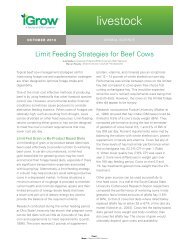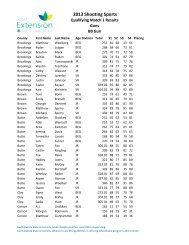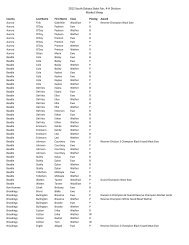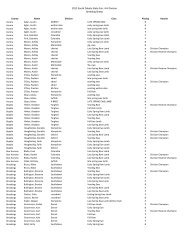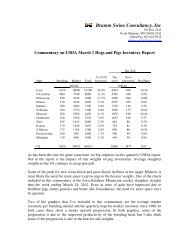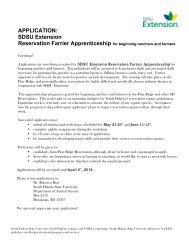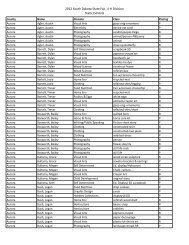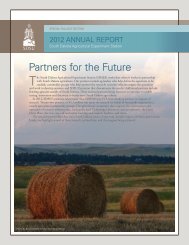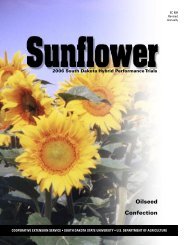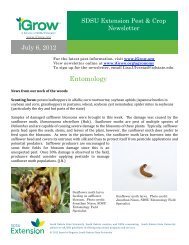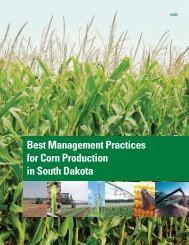Best Management Practices for Corn Production in South Dakota
Best Management Practices for Corn Production in South Dakota
Best Management Practices for Corn Production in South Dakota
You also want an ePaper? Increase the reach of your titles
YUMPU automatically turns print PDFs into web optimized ePapers that Google loves.
ii<br />
About 5 million acres of <strong>South</strong> <strong>Dakota</strong> land—close to 10% of<br />
our state’s land resources—are devoted to corn production. This<br />
fact alone makes it clear just how important corn production is<br />
to the economy of the state of <strong>South</strong> <strong>Dakota</strong>. But throw <strong>in</strong> recent<br />
developments <strong>in</strong> <strong>South</strong> <strong>Dakota</strong>’s corn-based ethanol <strong>in</strong>dustry, and<br />
the result is an even further elevation of corn—an elevation to a<br />
most prom<strong>in</strong>ent position with<strong>in</strong> the economy of our state.<br />
For the last century, the <strong>in</strong>tensity of farm<strong>in</strong>g management has<br />
cont<strong>in</strong>ued to escalate. This best management practices manual has<br />
brought together some of the best of both old and new technology.<br />
It is my belief that this manual will be a significant<br />
reference and resource <strong>for</strong> every <strong>South</strong> <strong>Dakota</strong> corn producer.<br />
To all who participated <strong>in</strong> the development of <strong>Best</strong> <strong>Management</strong> <strong>Practices</strong> <strong>for</strong> <strong>Corn</strong><br />
<strong>Production</strong> <strong>in</strong> <strong>South</strong> <strong>Dakota</strong>, I both extend my appreciation and offer a commendation<br />
<strong>for</strong> a job well done.<br />
Latif Lighari, Ph.D.<br />
Associate Dean and Director<br />
<strong>South</strong> <strong>Dakota</strong> State University<br />
<strong>South</strong> <strong>Dakota</strong> Cooperative Extension Service<br />
Professor of Agricultural Education<br />
College of Agriculture and Biological Sciences<br />
<strong>South</strong> <strong>Dakota</strong> corn producers are some of the most productive<br />
<strong>in</strong> the nation. Our state ranked sixth <strong>in</strong> the nation <strong>in</strong> production<br />
of corn <strong>for</strong> gra<strong>in</strong> <strong>in</strong> 2007 and has led the nation <strong>in</strong> planted acres of<br />
genetically eng<strong>in</strong>eered corn hybrids s<strong>in</strong>ce 2000. And yet, our corn<br />
producers face many challenges each year. Each producer must<br />
make the best decision on which corn hybrid to plant, choose the<br />
best fertilizer program, manage high <strong>in</strong>put costs, expect seasonal<br />
hazards, deal with weeds and pests, and market the harvest <strong>for</strong> the<br />
greatest profit.<br />
This manual presents the best management practices developed<br />
<strong>for</strong> the chang<strong>in</strong>g environment of corn production agriculture<br />
<strong>in</strong> <strong>South</strong> <strong>Dakota</strong>. From detailed, basic <strong>in</strong><strong>for</strong>mation on<br />
corn growth and development, through each phase of the corn<br />
production process, the authors and contributors have provided corn producers with an<br />
up-to-date and <strong>in</strong>valuable reference tool.<br />
I extend my congratulations to the editors, reviewers, authors, and contributors <strong>for</strong><br />
a job well done.<br />
Bill Even<br />
<strong>South</strong> <strong>Dakota</strong> Secretary of Agriculture



